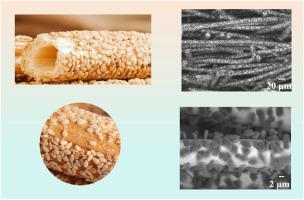复合电沉积法合成具有“颗粒上棒”微观结构的ni -金刚石杂化增强碳纤维/环氧导热复合材料
IF 9.8
1区 材料科学
Q1 MATERIALS SCIENCE, COMPOSITES
引用次数: 0
摘要
环氧基复合材料凭借其轻量化和设计灵活性,已成为热管理和电磁屏蔽应用的关键材料。高性能领域的快速发展带动了对多功能环氧复合材料的需求。在本研究中,采用复合电沉积的方法将镍-金刚石(N-D)杂化导热填料共沉积在聚丙烯腈(PAN)基碳纤维毡上。我们采用Watts浴作为电沉积溶液,精确控制电流密度和金刚石颗粒浓度,实现了金刚石颗粒在碳纤维基体内的均匀分散和强界面结合,从而优化了环氧复合材料的综合性能。在电流密度为2 A/dm2、金刚石浓度为16 g/L的最佳条件下,制备的环氧复合材料具有优异的导热系数(3.17 W/mK)、优异的电导率(37.7 S/cm)和显著降低的摩擦系数(0.44)。进一步的热管理测试证明了该复合材料卓越的传热性能,为高度集成电子器件的散热提供了可行的解决方案。本文章由计算机程序翻译,如有差异,请以英文原文为准。

Synthesis of Ni-diamond hybrid reinforced carbon fiber/epoxy thermally conductive composites with "Rod-on-particle microstructure" via composite electrodeposition
Epoxy-based composites, leveraging their lightweight nature and design flexibility, have emerged as critical materials for thermal management and electromagnetic shielding applications. The rapid advancement of high-functional fields have driven the demand for multifunctional epoxy composites. In this study, nickel-diamond (N-D) hybrid thermally conductive fillers were co-deposited onto polyacrylonitrile (PAN)-based carbon fiber felts via composite electrodeposition. Using Watts bath as the electrodeposition solution, we precisely controlled both current density and diamond particle concentration to achieve uniform dispersion of diamond particles and strong interfacial bonding within the carbon fiber matrix, thereby optimizing the comprehensive performance of epoxy composites. Under the optimal conditions of 2 A/dm2 current density and 16 g/L diamond concentration, the fabricated epoxy composite demonstrated superior thermal conductivity (3.17 W/mK), excellent electrical conductivity (37.7 S/cm), and a significantly reduced friction coefficient (0.44). Further thermal management tests demonstrated the composite's exceptional heat-transfer performance, offering a viable solution for thermal dissipation in highly integrated electronics.
求助全文
通过发布文献求助,成功后即可免费获取论文全文。
去求助
来源期刊

Composites Science and Technology
工程技术-材料科学:复合
CiteScore
16.20
自引率
9.90%
发文量
611
审稿时长
33 days
期刊介绍:
Composites Science and Technology publishes refereed original articles on the fundamental and applied science of engineering composites. The focus of this journal is on polymeric matrix composites with reinforcements/fillers ranging from nano- to macro-scale. CSTE encourages manuscripts reporting unique, innovative contributions to the physics, chemistry, materials science and applied mechanics aspects of advanced composites.
Besides traditional fiber reinforced composites, novel composites with significant potential for engineering applications are encouraged.
 求助内容:
求助内容: 应助结果提醒方式:
应助结果提醒方式:


